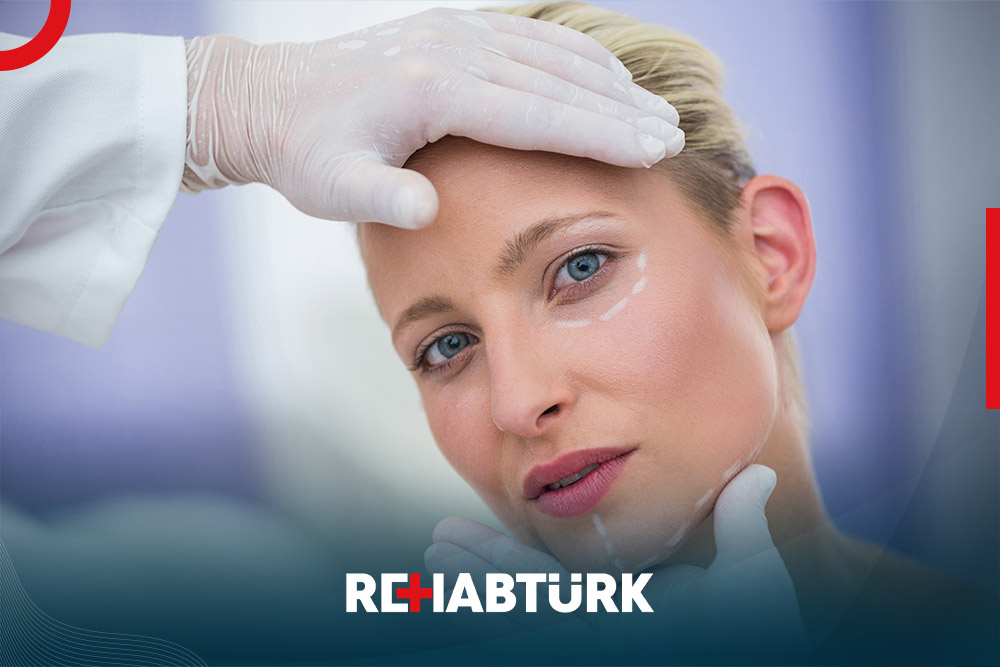Facelift with threads in Türkiye
A Facelift with threads is a procedure that is also called a barbed thread lift. It is a cosmetic procedure that aims to lift and sculpt the shape of the face. A temporary, medical-grade suture material is used to “sew” the skin so that it is taut.
Thread lifts have been around since the 1990s, but innovations in the materials used in thread lifts have increased their popularity in recent years.
The ideal candidate for a thread lift procedure is someone in their late 30s to early 50s. People who are in generally good health and are beginning to notice signs of aging may benefit from the procedure.
Those who cannot have a surgical facelift may consider a thread lift as a safer alternative due to certain medical conditions that can make general anesthesia risky.
How much does a facelift with threads cost?
The costs of a facelift with threads vary according to the place where the patient lives, the extent of experience of the doctor performing the procedure, and the number of areas he targets for treatment.
One doctor estimated that a thread facelift usually costs 40% of the cost of a traditional facelift.
The forehead, jawline, under-eye area, and eyebrow are all parts of the face that can be considered for a thread lift procedure. You can choose to target only one area or several at a time, which increases the cost. Thread lift to lift the breasts may be more expensive.
Thread lift does not require general anesthesia, which saves the cost of anesthesia. The procedure does not require taking time off from work to recover. Also, the recovery period is very short.
Your plastic surgeon may recommend additional treatments or other cosmetic procedures such as botulinum toxin or fillers to enhance the results of a thread lift. All costs associated with these procedures must be ascertained.

How is a facelift performed with threads?
Face lift with threads is done in two ways:
The first is very clear. It is done by suturing thin, soluble threads under the skin, and the doctor is able to tighten the skin tightly around the forehead, neck, or torso.
These invisible and painless “strings” hold the skin tight and it must be ensured that the thread grips the inner tissues and muscles when the thread is pulled tight.
Once the barbed wire is inserted into the body, the healing process begins within the body. Although no subcutaneous injury occurs during a thread lift, the body detects suture material and stimulates collagen production in the injured area. And collagen can fill gaps in sagging skin and restore more youthful elasticity to the face.
A small 2017 study indicated that the primary effect of a thread lift is skin appearing tighter and more structured. A year after the procedure, this effect begins to diminish as the sutures dissolve. but nevertheless! There was a secondary “rejuvenation” effect that remained in place and was noticeable 3 or more years after the procedure.
In a 2019 literature review of thread tension, I concluded that more research is needed to understand the long-term effects, as the technology and methods of providing thread tension continue to evolve.
How to perform a thread lift
The thread lift procedure may vary slightly depending on the area being targeted as well as the doctor’s preferences. The basic technique is usually the same.
- The patient is asked to lie down in the room where the procedure is performed. Alcohol, along with a local anesthetic, is applied to the skin while preparing for the procedure.
- A thin needle or cannula is used to insert the sutures under the skin. Inserting the sutures can take anywhere from 30 to 45 minutes.
- After insertion of the sutures, the insertion aids are removed. The patient may then feel a slight pressure or tightening under the skin.
- Within a few minutes of the needles being taken out, the procedure will be complete and the patient will be free to go home.
Targeted places for facelift with threads
Many people choose a thread lift to solve problems with areas of the face that have drooped or appear saggy over time. These areas include:
- Jaws and jawbone lines
- eyebrow line
- area under the eye
- forehead
- cheeks
Thread lift is also used to lift and tighten the breasts, especially after pregnancy and weight loss.
Are there risks or side effects?
A thread lift is a low-risk procedure, but there are side effects and a risk of complications.
It is not uncommon for the following to occur after a thread lift:
- bruises
- swelling
- bleeding
- Mild pain at the thread injection site
There is a 15 to 20% chance of complications, including implantation. The potential complications are minor and easily correctable. Complications to look out for include:
- Allergic reaction to components in the suture material
- Bleeding accumulated behind the skin as a result of the procedure
- Visible indentation or pulling from where the sutures were inserted
- Unintentional migration or “movement” of the threads that leads to lumpy skin or puffiness
- Pain under the skin due to “pulling” or improper placement of the suture
- An infection at the procedure site
Of all the risks of a thread lift, you should be aware of any infection. You should contact your doctor immediately if you notice:
- Green, black, brown, or red discharge at the procedure site
- swelling for more than 48 hours
- continuous headache
- Fever
What do you expect after a facelift with threads?
The recovery time after a successful thread lift is minimal. While there may be some visible swelling and bruising, it is possible to return to work immediately if desired.
Results should be visible immediately after the sutures are put in place, but more may be noticed in the days and weeks immediately following their insertion, as swelling and bruising begin to subside.
The results of a thread lift do not have to be permanent. Successful results usually last 1 to 3 years. As with other soluble dermal fillers, such as botulinum toxin, the threads are eventually absorbed by the tissues beneath the skin.
The usual routine can be resumed after the thread lift procedure. The doctor may advise not to rub the face vigorously and to avoid sleeping on the side in the first weeks after the procedure. It is also advised to avoid saunas and strenuous exercises for the first week or so after your thread lift procedure.
Preparing for thread lift
After consulting with the doctor and scheduling the appointment, you may be given some instructions on what to do and what not to do to prepare for a thread lift.
What to do:
- Tell your doctor about any medications you are taking before the procedure
- Relax and avoid stress the night before
- Stay away from any known inflammatory triggers in your diet
What not to do:
- Drinking alcohol the night before the thread lift
- Take blood-thinning medications or non-steroidal anti-inflammatory drugs (such as ibuprofen ) one week before thread lift.
Facelift with threads vs. surgical facelift!
A thread facelift will not give the same dramatic results as a surgical facelift. When considering this procedure, it’s important to have realistic expectations for it.
Thread lift is not permanent results! A surgical facelift cannot completely reverse the effects of aging, but the results last for many years. The subtle results of a thread lift usually last for about two years.
To make the results last longer, the patient may need to resort to fillers or other treatments that cost additional time and money.
On the other hand, the risks of complications in surgical facelift surgery are much higher. If the results of a surgical face-lift are not satisfactory, there is not much that can be done except for another surgery. But if the results of the facelift with threads are not satisfactory, you can simply wait for the threads to dissolve.
A thread facelift is less expensive than a surgical facelift. You can return to work immediately after completion, and the recovery period is minimal.
When noticing signs of aging in the jawline or under the eyes, a thread facelift is the ideal, low-risk way to see what the permanent procedure might look like.
How to do a facelift with threads in Türkiye
Finding a licensed and trained clinician and physician is very important if you are considering getting a thread lift. Since the possibility of complications is much less with the presence of an experienced doctor.
So first search for the best service providers in Türkiye and the best plastic surgeons for thread lift. And then make reservation procedures and travel for treatment.
And you can get the best options by contacting REHABTÜRK HEALTHCARE PROVIDER NETWORK, which provides you with the best experienced doctors.
How can I book a facelift with threads in Türkiye?

- Free medical support on the phone: You will have a dedicated representative for your health condition who is always ready to answer your questions.
- Free consultation with a specialist doctor: Your medical representative will consult with a number of doctors and hospitals to find the best possible treatments.
- Free travel visa arrangement: We will contact the embassy in your country to assist you in obtaining a visa to visit Türkiye.
- Free itinerary planning: We will create a schedule for your medical trip to Türkiye.
- Free translation of documents and reports: We will translate medical documents and reports into Turkish on your behalf.
- Free support and monitoring: We will monitor the stages of treatment and be by your side every step of the way.
- Free instant translation: We will be with you during the treatment stages to provide translation between you and the medical team.
- Free accommodation and transportation coordination: We will book accommodation for you and your companions in Türkiye, along with transportation services.
Contact REHABTÜRK doctors for more information about the procedure and to evaluate your medical condition.
